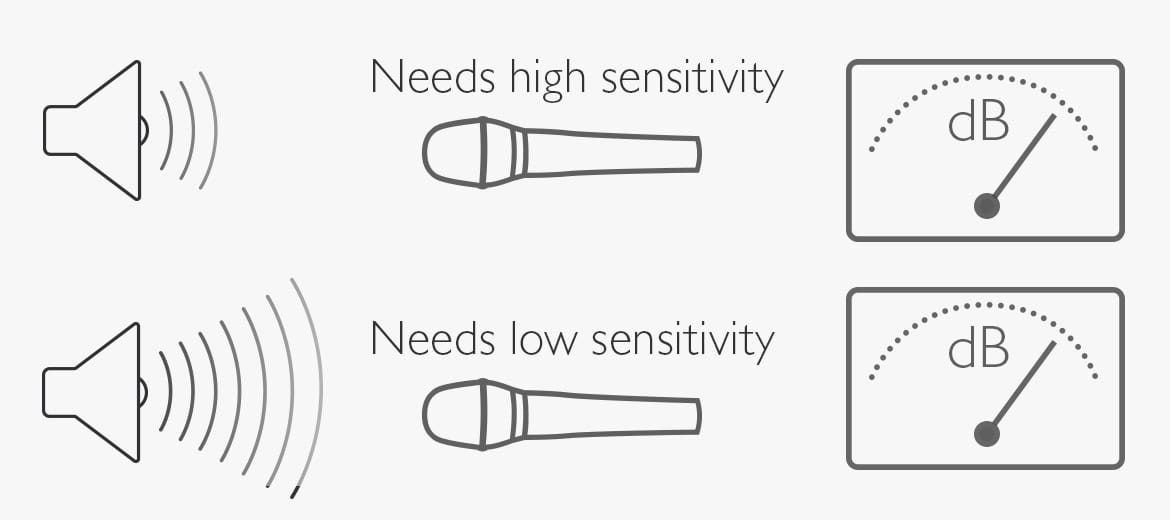Simplified Guide to Microphone Sensitivity
This article aims to clarify the differences in sensitivity specifications between analog and digital microphones, guide you in selecting the right microphone for your application, and explain how digital gain can enhance microphone performance.

Introduction
Microphone sensitivity, the ratio of the output signal (either analog voltage or digital value) to the input sound pressure, is a crucial specification for any microphone. It essentially determines how effectively a microphone converts acoustic energy into electrical signals. This article aims to clarify the differences in sensitivity specifications between analog and digital microphones, guide you in selecting the right microphone for your application, and explain how digital gain can enhance microphone performance.
Analog vs. Digital Microphones
Microphone sensitivity is typically measured with a 1 kHz sine wave at a 94 dB sound pressure level (SPL), which corresponds to 1 pascal (Pa) of pressure. The resulting output signal's magnitude is a direct measure of the microphone's sensitivity. However, sensitivity alone does not define the entire performance of a microphone.
Analog Microphones
The sensitivity of an analog microphone is often expressed in decibels relative to 1 volt (dBV). For instance, if a microphone has a sensitivity of -38 dBV, it means the microphone outputs a voltage when exposed to a sound pressure level of 94 dB SPL.
With this information, you can use a preamplifier to adjust the microphone's output signal to match the input level of the rest of your audio system. For example, if an analog microphone like the ADMP504 has a maximum output of 0.25 V, you can use a gain of 4 (12 dB) to match it to an ADC with a 1.0 V full-scale peak input voltage.
Digital Microphones
The sensitivity of digital microphones is measured in decibels relative to full scale (dBFS). Unlike analog microphones, the output of digital microphones is constrained by their design, specifically the maximum acoustic input they can handle. For example, if a digital microphone has a maximum SPL of 120 dB, its sensitivity will be -26 dBFS (94 dB - 120 dB).
In digital microphones, sensitivity is a percentage of the full-scale output produced by a 94 dB SPL input. The conversion equation is:
One crucial difference between analog and digital microphones is how they handle peak and RMS levels. Analog microphones usually reference their output to RMS levels, while digital microphones use peak levels because they refer to the full-scale digital word. This distinction is important for configuring downstream signal processing, such as dynamic range processors, which typically set thresholds based on RMS levels. For a sinusoidal input, the RMS level is 3 dB below the peak level. For example, an ADMP421 microphone with a sensitivity of -26 dBFS will have an RMS output level of -29 dBFS for a 94 dB SPL sinusoidal input.
Comparing Sensitivities
Comparing analog and digital microphones can be confusing due to their different sensitivity units. However, they share a common reference in the acoustic domain, SPL. By focusing on SPL, you can compare the maximum acoustic input and signal-to-noise ratio (SNR) of different microphones. Figure 2 illustrates the relationship between acoustic input and output levels for both analog and digital microphones.
Choosing the Right Sensitivity
Choosing the right microphone sensitivity depends on your specific application:
- High Sensitivity: Suitable for applications where the sound source is distant, such as conference phones and security cameras. Higher sensitivity ensures the microphone can pick up faint sounds from a distance.
- Low Sensitivity: Better for close-up applications, like in cell phones, to avoid clipping and distortion from loud inputs.
Figure 3 shows how sound pressure level decreases with distance from the source. Each time the distance is doubled, the SPL drops by 6 dB. Figure 4 provides examples of SPL levels for various sound sources, from quiet recording studios to the threshold of pain.
Setting the Gain
- Analog Microphones: You can adjust the output level using preamp gain. However, each gain stage can introduce noise, so it’s essential to ensure the preamp is quiet enough not to degrade the audio signal. Analog microphones have a wide range of sensitivities, typically between -46 dBV and -35 dBV (5.0 mV/Pa to 17.8 mV/Pa).
- Digital Microphones: Sensitivity might seem less flexible, but you can easily adjust the signal level using digital gain without adding noise, provided the digital processor has enough bits to handle the dynamic range. For instance, the ADMP441 digital microphone with an I2S output has a maximum SPL of 120 dB and a noise floor of 33 dB SPL, resulting in an 87 dB dynamic range. This can be reproduced with a 15-bit data word. Using a 16-bit audio processor allows for gain adjustments without compromising the original dynamic range.
Figure 5 illustrates a digital microphone connected directly to a DSP, showing how the peak output level can match the DSP's full-scale input word without needing an intermediate gain stage.
Conclusion
Understanding microphone sensitivity is essential for selecting the right microphone and optimizing your audio system. Sensitivity, while related to SNR, is not an indicator of microphone quality. Both analog and digital microphones have their advantages, and the choice depends on the specific requirements of your application. By considering factors like the intended distance from the sound source and the necessary dynamic range, you can make an informed decision and achieve the best performance from your microphone.
In summary, this guide has explained how to understand microphone sensitivity, apply it to your audio system’s gain staging, and ensure you choose the best microphone for your needs. Whether you're working with analog or digital microphones, this knowledge will help you get the fullest performance from your audio devices.